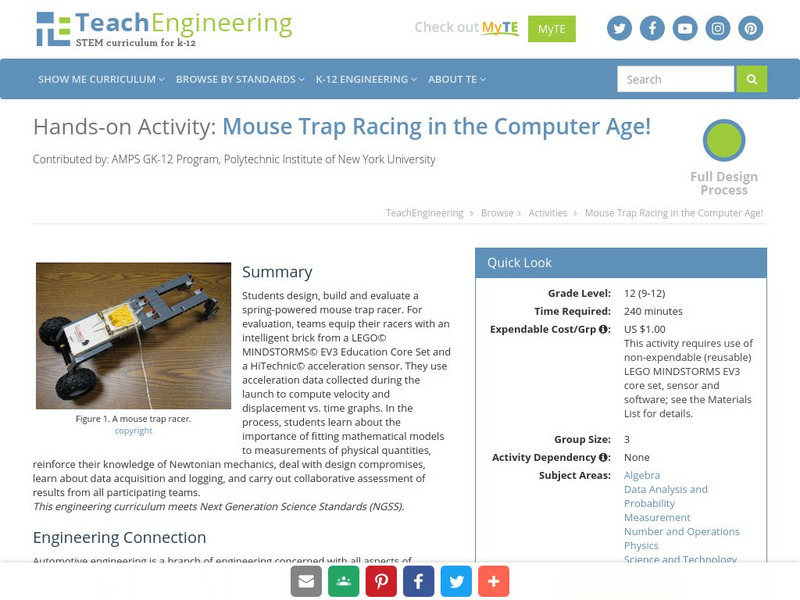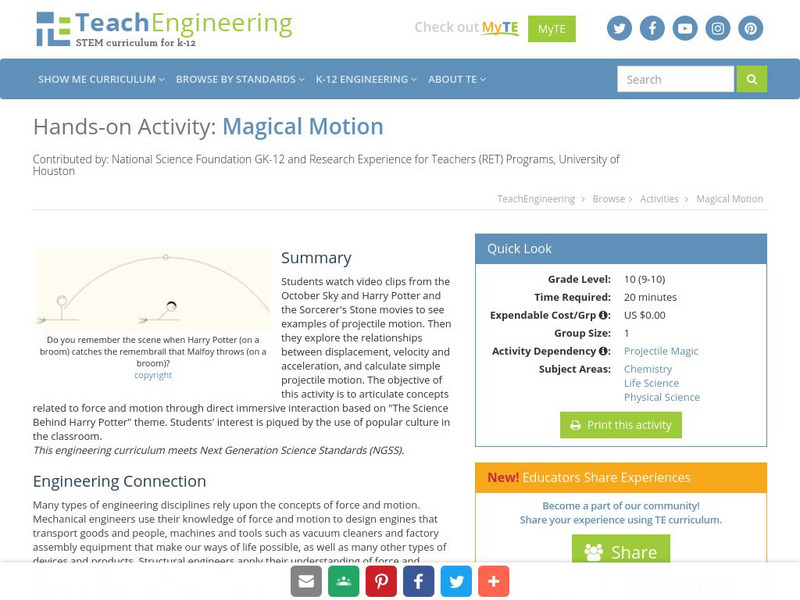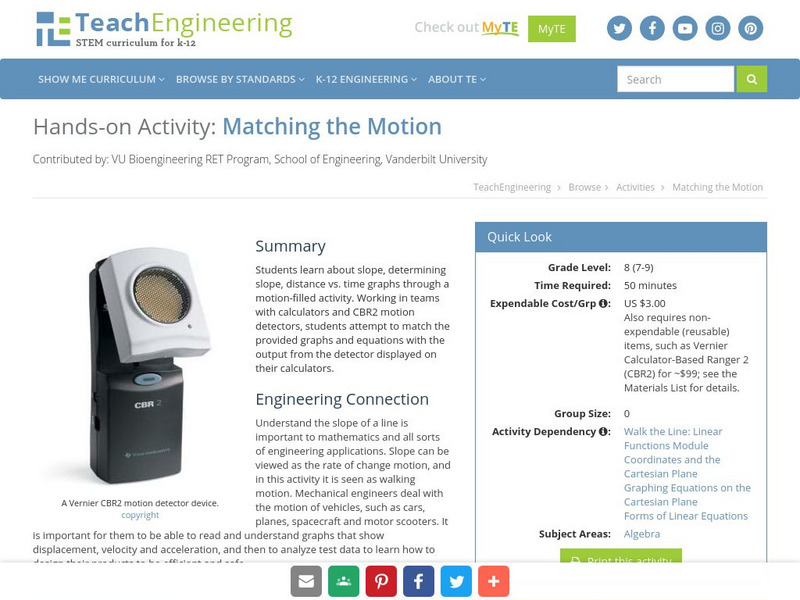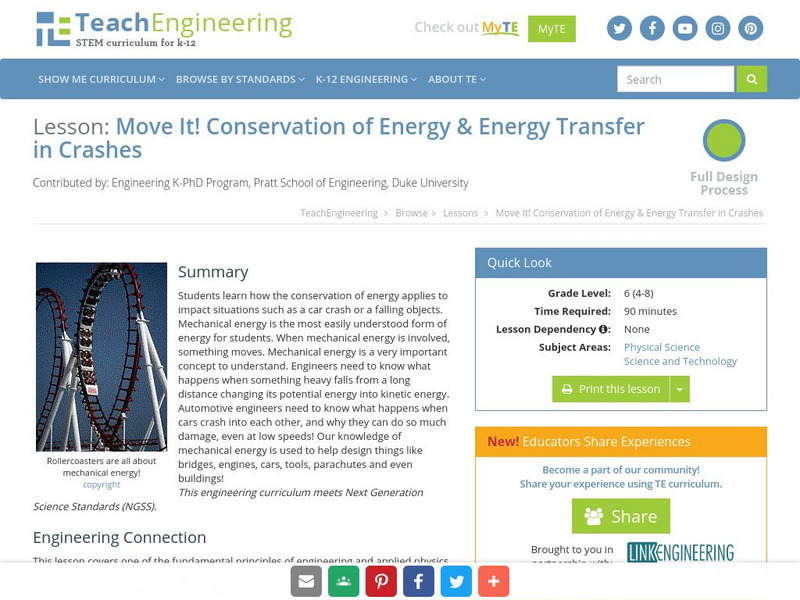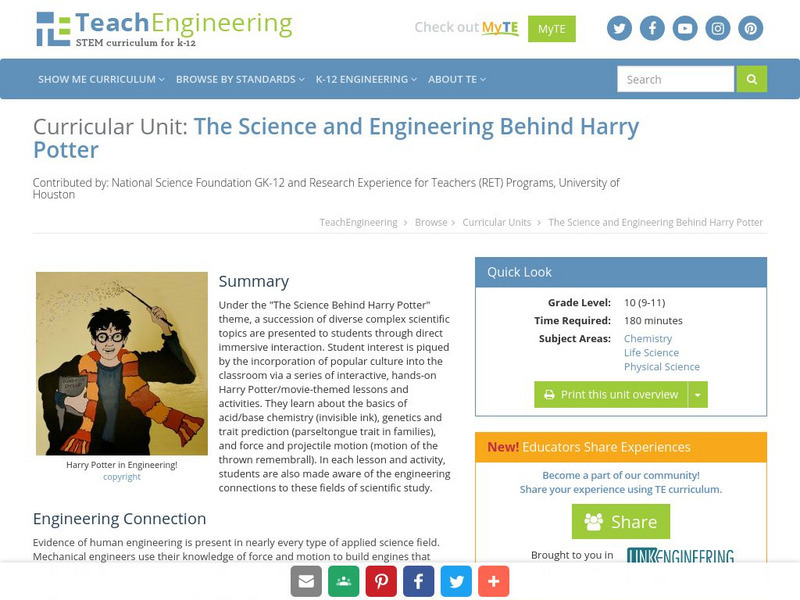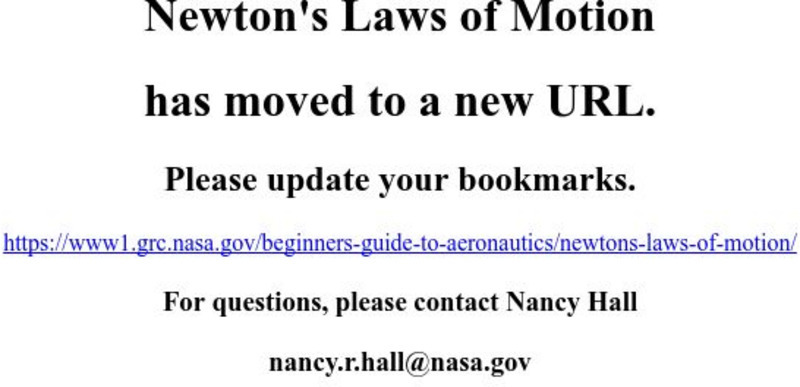TeachEngineering
Teach Engineering: Mouse Trap Racing in the Computer Age!
Students design, build and evaluate a spring-powered mouse trap racer. For evaluation, teams equip their racers with an intelligent brick from a LEGO MINDSTORMS NXT Education Base Set and a HiTechnic acceleration sensor. They use...
TeachEngineering
Teach Engineering: Magical Motion
Students watch video clips from the October Sky and Harry Potter and the Sorcerer's Stone movies to see examples of projectile motion. Then they explore the relationships between displacement, velocity and acceleration, and calculate...
TeachEngineering
Teach Engineering: Matching the Motion
Students learn about slope, determining slope, distance vs. time graphs through a motion-filled activity. Working in teams with calculators and CBL motion detectors, students attempt to match the provided graphs and equations with the...
TeachEngineering
Teach Engineering: Physics of the Flying T Shirt
Students are introduced to the physics concepts of air resistance and launch angle as they apply to catapults. This includes the basic concepts of position, velocity and acceleration and their relationships to one another. They use...
TeachEngineering
Teach Engineering: Move It!
Mechanical energy is the most easily understood form of energy for learners. When there is mechanical energy involved, something moves. Mechanical energy is a very important concept to understand. Engineers need to know what happens when...
TeachEngineering
Teach Engineering: What Is Newton's First Law?
Students are introduced to the concepts of force, inertia, and Newton's first law of motion: objects at rest stay at rest and objects in motion stay in motion unless acted upon by an unbalanced force.This lesson is the first in a series...
TeachEngineering
Teach Engineering: Projectile Magic
Learners watch video clips from October Sky and Harry Potter and the Sorcerer's Stone to learn about projectile motion. They explore the relationships between displacement, velocity and acceleration and calculate simple projectile...
TeachEngineering
Teach Engineering: What's Up With All This Traffic?
Expanding on the topic of objects in motion covering Newton's laws of motion, acceleration and velocity, which are taught starting in third grade, students are introduced to new concepts of speed, density, level of service (LOS) (quality...
Texas Education Agency
Texas Gateway: Introduction to Motion
What do you think of when you hear the word motion? Are you moving right now? You may not think so, but you are. Remember, the Earth is moving around the Sun, and the Sun is moving around the Milky Way Galaxy. Everything in the universe...
South Carolina Educational Television
Etv: The Hobby Shop: The Rocket
Design your own virtual rocket, and then test launch it. Watch tutorials about Newton's laws of motion and rocket basics to help you improve your rocket's performance.
Physics Classroom
The Physics Classroom: Projectile Motion
Scroll down to Lesson 2 for a complete tutorial on projectile motion. Content covered in these tutorials includes an explanation of what a projectile is, what the characteristics of a projectile's trajectory are, horizontal and vertical...
Stanford University
Stanford University: Conventionality of Simultaneity
This site from Stanford University is on the topic of simultaneity in relativity.
TeachEngineering
Teach Engineering: The Great Gravity Escape
Middle schoolers use water balloons and a length of string to understand how gravity and the velocity of a spacecraft balance to form an orbit. They see that when the velocity becomes too great for gravity to hold onto an object, the...
TeachEngineering
Teach Engineering: Engineering Out of Harry Situations
Under the "The Science Behind Harry Potter" theme, a succession of diverse complex scientific topics are presented to students through direct immersive interaction. Student interest is piqued by the incorporation of popular culture into...
CK-12 Foundation
Ck 12: Episd: Velocity 1
[Free Registration/Login may be required to access all resource tools.] Using mathematic equations for speed and velocity students will breakdown one dimensional motion.
Texas Education Agency
Texas Gateway: Types of Motion
Students will distinguish between and/or interpret the types of motion.
Texas Education Agency
Texas Gateway: Changes in Motion
Given diagrams or scenarios, students will measure and graph changes in motion.
Paul Dawkins
Paul's Online Notes: Velocity and Acceleration
Interactive notes with links to previous concepts, examples, and solutions.
Science Struck
Science Struck: A Comprehensive List of All the Physics Formulas
Provides a long list of physics formulas for easy reference.
Physics Classroom
The Physics Classroom: Vectors and Direction
A complete lesson/tutorial on vectors. Learn about vector addition, vector resolution, vector components, and resultants. Numerous examples and learning exercises are provided.
Texas Education Agency
Texas Gateway: Ap Physics: 2.3 Time, Velocity, and Speed
By the end of this section, you will be able to do the following: Explain the relationships between instantaneous velocity, average velocity, instantaneous speed, average speed, displacement, and time; Calculate velocity and speed given...
Physics Classroom
The Physics Classroom: Acceleration
Topics covered include what acceleration is, the difference between constant and non-constant acceleration, acceleration in a free-falling object, the equation used to compute acceleration, and the difference between positive and...
CK-12 Foundation
Ck 12 Exploration Series: Simulations: Physics: Model Rocket
[Free Registration/Login Required] Learn about the relationship between position and velocity for a model rocket during launch and in free-fall. Experiment with rocket mass, rocket thrust, and rocket burn time to understand the...
NASA
Glenn Research Center: Newton's Laws of Motion
NASA presents a concise explanation of Newton's three laws of motion. Click on the highlighted vocabulary to find more detailed and illustrated descriptions. Included is a link to a movie that shows how the laws of motion described the...


